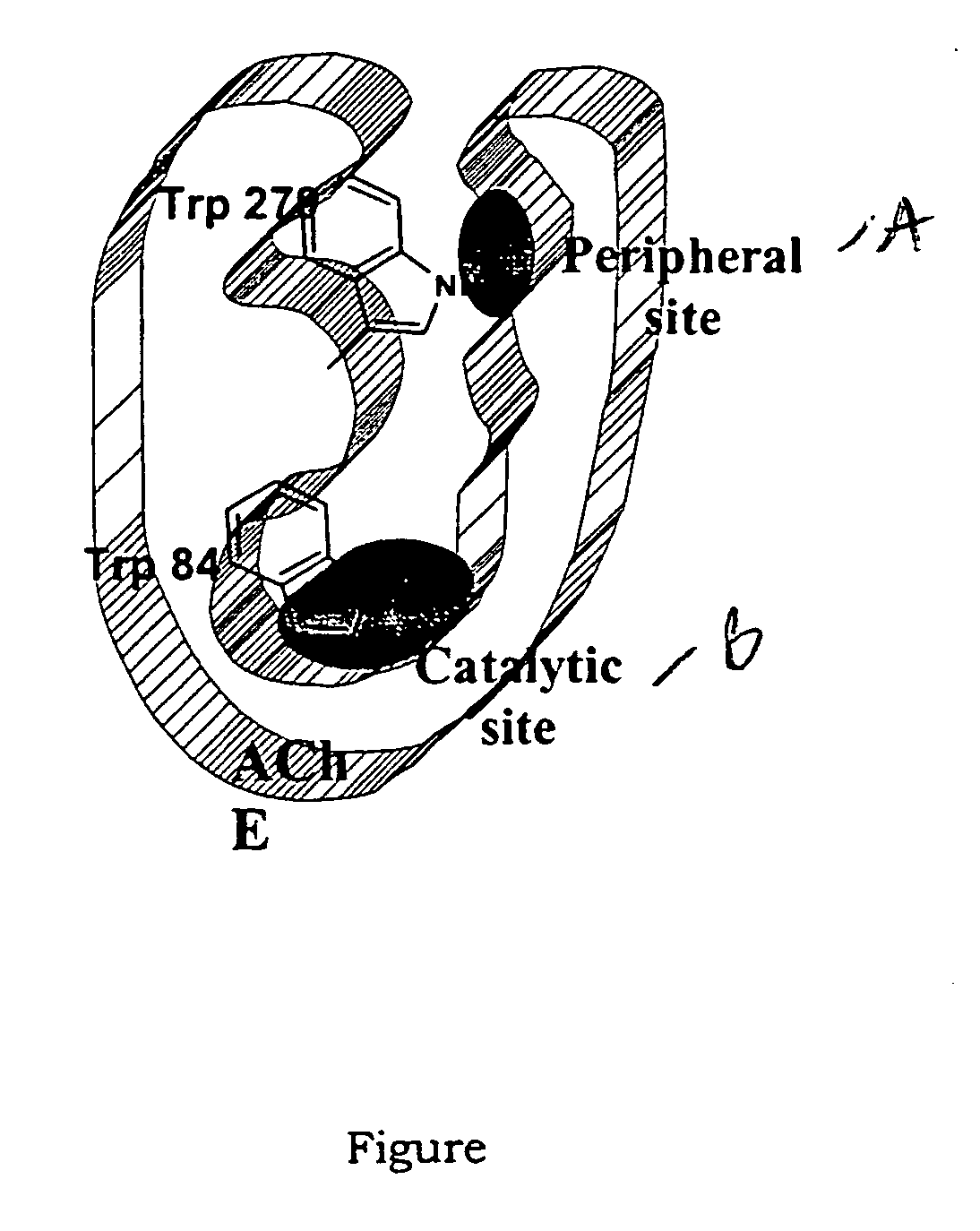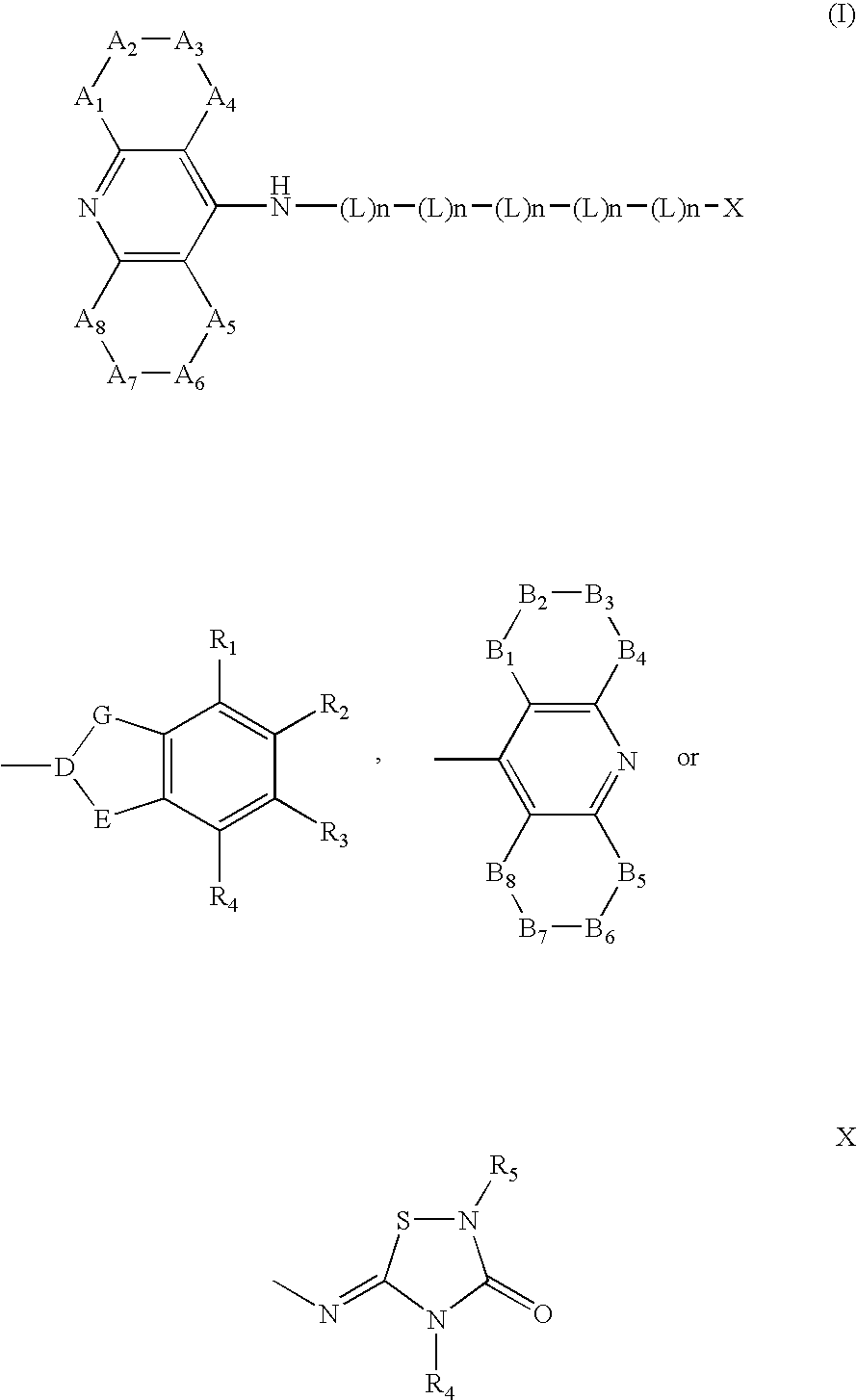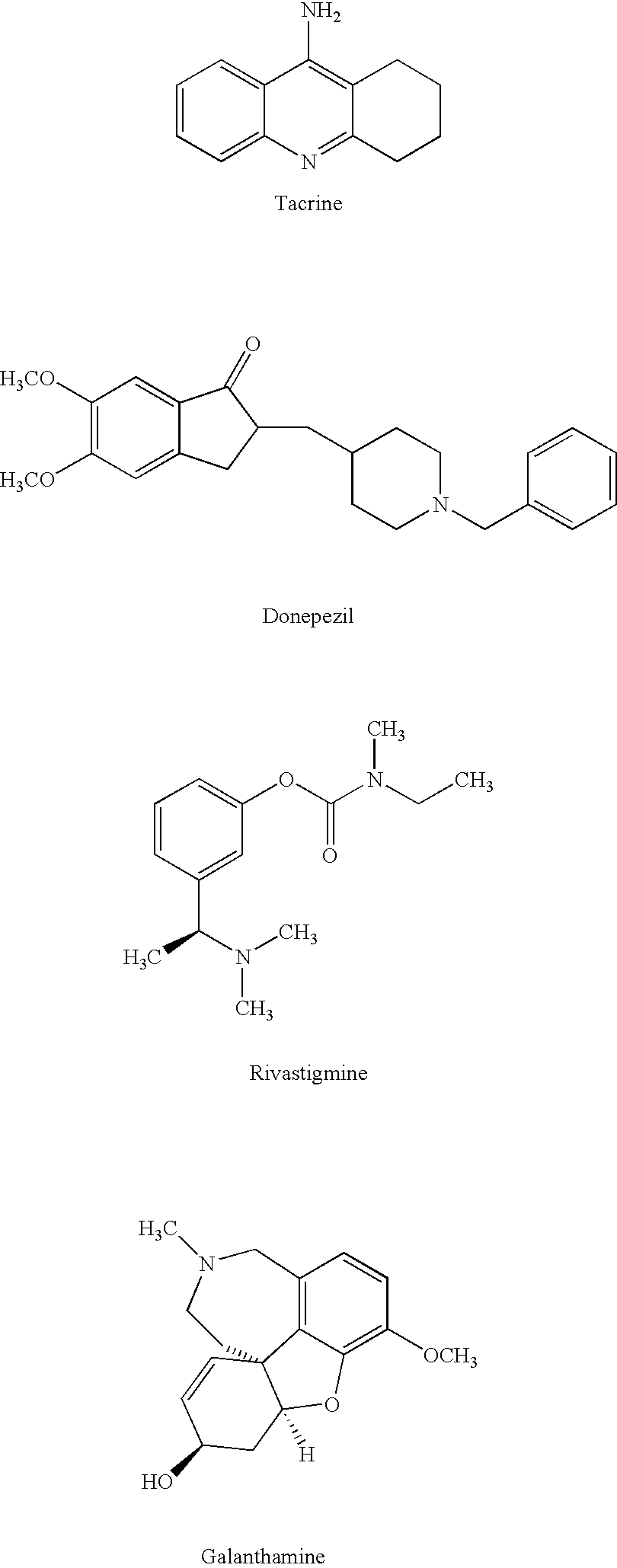Dual binding site acetylcholinesterase inhibitors for the treatment of alzheimer's disease
a technology of acetylcholinesterase and binding site, which is applied in the direction of biocide, cardiovascular disorder, drug composition, etc., can solve the problem of increasing the neurotoxicity of a fibrils
- Summary
- Abstract
- Description
- Claims
- Application Information
AI Technical Summary
Benefits of technology
Problems solved by technology
Method used
Image
Examples
example 1
5,6-Dimethoxy-2-{[7-(1,2,3,4-tetrahydro-acridin-9-ylamino)-heptylamino]-methyl}-indan-1-one
[0094]
[0095] To a stirred solution of 9-(7-aminoheptylamino)-1,2,3,4-tetrahydroacridine (134 mg, 0.43 mmol) in a mixture of ethanol: water 3:1 (3.5 ml) at room temperature, paraformaldehyde (26 mg, 0.86 mmol) and 5,6-dimethoxyindan-1-one (83 mg, 0.43 mmol) were added. The pH was adjusted to 3 with 35% hydrochloric acid and the mixture were refluxed for 24 hours. At the end of this period, the reaction mixture was cooled (25° C.), the solvent was removal under vacuum pressure and the residue was treated with K2CO3 saturated solution (3.5 ml) and methylene chloride (5 ml). The organic layer was washed with water (5 ml) and dried (anhydrous Na2SO4). The solvent was removed under vacuum and the residue was purified by preparative centrifugal thin layer chromatography. Elution with 5:1 ethyl acetate: methanol containing 1% of aquous ammonia afforded the title compound as yellow syrup (15 mg, 6.8%)...
example 2
5,6-Dimethoxy-2-{[6-(1,2,3,4-tetrahydro-acridin-9-ylamino)-hexylamino]-methyl}-indan-1-one
[0099]
[0100] According to the general procedure in Example 1, 9-(6-aminohexylamino)-1,2,3,4-tetrahydroacridine (96 mg, 0.32 mmol), paraformaldehyde (19 mg, 0.64 mmol), 5,6-dimethoxyindan-1-one (62 mg, 0.32 mmol) and 35% hydrochloric acid (pH=3) were refluxed for 24 hours. Purification by two preparative centrifugal thin layer chromatographies eluting with 10:1 ethyl acetate: methanol containing 2% of aquous ammonia afforded the title compound as yellow syrup (8 mg, 5%).
[0101]1H-NMR (CDCl3, 300 MHz, δ): 7.97 (dd, 2H, J=8.1 Hz), 7.56 (ddd, , 1H, J=8.1, 1.2 Hz), 7.34 (ddd,, 1H, J=8.2, 1.2 Hz), 7.13 (s, 1H), 6.85 (s, 1H), 3.94 (s, 3H), 3.88 (s, 3H), 3.55 (t, 2H, J=7.0 Hz), 3.30-3.19 (m, 1H), 3.10-3.07 (m, 2H), 2.90-2.60 (m, 7H), 1.89-1.68 (m, 4H), 1.40-1.35 (m, 2H), 1.28-1.11 (m, 6H).
[0102]13C-NMR (CDCl3, 300 MHz, δ): 207.1, 155.7, 151.2, 149.4, 149.3, 129.3, 128.7, 128.3, 123.8, 123.0, 107.4, 1...
example 3
2-[6-(1,2,3,4-Tetrahydro-acridin-9-ylamino)-hexylamino]-indan-1,3-dione
[0104]
[0105] To a stirred solution of (1,2,3,4-Tetrahydro-acridin-9-yl)-hexane-1,6-diamine oxalate (339 mg, 0.87 mmol) in a mixture of ethanol: water 3:1 (3.5 ml) at room temperature, paraformaldehyde (26.4 mg, 0.88 mmol) and Indan-1,3-dione (129 mg, 0.88 mmol) were added. The pH was adjusted to 3 with 35% hydrochloric acid and the mixture were refluxed for 24 hours. At the end of this period, the reaction mixture was cooled (25° C.), the solvent was removal under vacuum pressure and the residue was treated with K2CO3 saturated solution (3.5 ml) and methylene chloride (5 ml). The organic layer was washed with water (5 ml) and dried (anhydrous Na2SO4). The solvent was removed under vacuum and the residue was purified by preparative centrifugal thin layer chromatography. Elution from 10:1 to 3:1 ethyl acetate:methanol containing 1% of aquous ammonia afforded the title compound as yellow syrup (17 mg, 4.4%).
[0106]...
PUM
| Property | Measurement | Unit |
|---|---|---|
| Molar density | aaaaa | aaaaa |
| Molar density | aaaaa | aaaaa |
| Inhibition | aaaaa | aaaaa |
Abstract
Description
Claims
Application Information
 Login to View More
Login to View More - R&D
- Intellectual Property
- Life Sciences
- Materials
- Tech Scout
- Unparalleled Data Quality
- Higher Quality Content
- 60% Fewer Hallucinations
Browse by: Latest US Patents, China's latest patents, Technical Efficacy Thesaurus, Application Domain, Technology Topic, Popular Technical Reports.
© 2025 PatSnap. All rights reserved.Legal|Privacy policy|Modern Slavery Act Transparency Statement|Sitemap|About US| Contact US: help@patsnap.com



